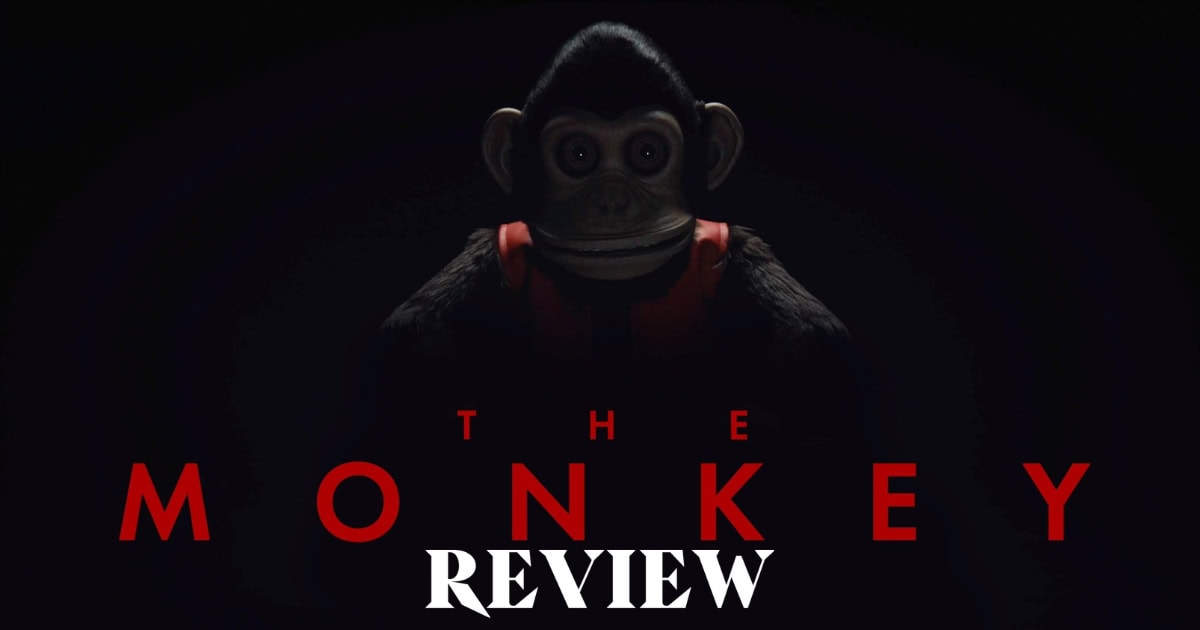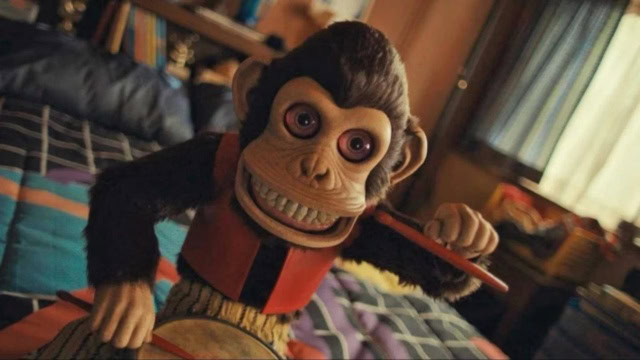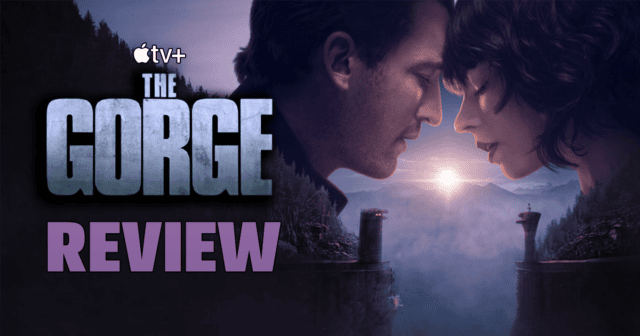Osgood Perkins’ ‘The Monkey’ is Neither Funny Nor Thrilling

After the incredible commercial success of Longlegs, bolstered by a clever marketing campaign, many audience members eagerly anticipated seeing what Osgood Perkins would come up with next. It turns out they didn’t have to wait very long, as his latest feature, The Monkey, was already in the can when Longlegs bowed out in cinemas. Adapted from the short story of the same name by Stephen King, The Monkey wants to enthrall audiences with a blend of dark humor peppered by sickly, over-the-top kills the titular character causes. The film aims for a more satisfying moviegoing experience than Perkins’ last go-around at filmmaking. Yet, it accomplishes very little, even if you know about the director’s personal life and experience with tragedy.
[Warning: spoilers discussed below for The Monkey]
The Monkey: the story
In the movie, we follow twin brothers Hal and Bill Shelburn (played in the first part by Christian Convery), who, after the disappearance of their father (Adam Scott), find a toy monkey in his closet with the words “Like Life” written on the box. As the monkey appears playful, the instructions that read “Turn the key and see what happens” seem harmless enough until it causes the gruesome death of someone closest to them. As a result, the two lock the monkey away in a well, hoping it won’t escape (it can teleport from one place to the next without explanation) and cause more harm to the quaint community the brothers live in.
Twenty-five years later, Hal (now played by Theo James) no longer speaks with Bill and struggles to connect with his son, Petey (Colin O’Brien). After receiving a call from his brother, who tells him of the shocking death of one of his family members, Hal suspects the monkey has managed to escape the well, despite being locked inside the toy’s box, and goes to Maine with his son, hoping to find it.
Compared to Perkins’ last directorial effort, The Monkey is less of an alienating affair and veers more into the crowd-pleasing route by staging one perversely funny kill after another, with a deadpan tone that most of its characters (notably through Tatiana Maslany, the film’s only true standout, as the twins’ mother) will convey.
This Osgood Perkins film has no sense of aesthetics in its staging of kills
Unfortunately, the two main draws that would make The Monkey such a fun time – good kills and being funny – are entirely absent inside a film that lacks a true sense of identity beyond the visual elements it consistently steals from. Many will compare the movie’s random, elaborate deaths to a set piece straight out of Final Destination, and with reason. Perkins certainly has fun staging kills that involve bowling balls, samurai swords, bees, fishing and grappling hooks, cobras, shotguns, etc. You name it, it’s probably here. Yet, he lacks the aesthetic sensibilities that could make these kills truly cathartic, not only in their visual impact but in how most characters react to such grisly offerings in front of their face.
Final Destination had panache. There was a real sense of planning in how each kill was staged, from inferring some aspects of the environment to establishing a sense of tangible tension with specific shot placements that would ultimately lead to an over-the-top demise. The gym setpiece in Final Destination 5 is an excellent example of this type of planning and execution. In The Monkey, Perkins only cares about the execution, which is fine for some time until it becomes increasingly tiresome that each death occurs at a sparse moment to “shock” the audience. It worked for a sum total of one, which involved a shotgun trap at the other side of the door, the only time I genuinely felt what the filmmaker wanted me to experience.
The rest of it gets rapidly tiresome, and it becomes clear that Perkins doesn’t have many tricks up his sleeves to make each kill feel fresh and exciting. It also doesn’t help that each image possesses no discernible flair to genuinely thrill the audience, particularly when its blocking feels so static that one may think they’re watching a student film made on a shoestring budget than an independent horror feature based on a work from one of our most treasured authors. The monkey design is notably effective, but what more does the movie have to offer when that novelty wears off?

The Monkey is rarely funny
Apparently, it’s a comedy! And if by “comedy” you mean the same type of cynical, quip-heavy junk we’d usually see in a Joss Whedon-written picture, then, sure, you may as well call it that. It is funny (pun intended) how no verbal joke lands, no matter how each actor repeats the same thing or says a variation of “Whoa! What the f–?? Holy sh—?” that passes as “comedy.” Even the mildly amusing visual stuff gets tedious when they’re also frequently repeated, making us wonder if Perkins truly has something of value to offer when stepping out of his usual comfort zone of “elevated horror” because we already know he has nothing to say after veering into supernatural and psychological terrors in his previous directorial efforts.
It’s strange to say, because Perkins has a relatively complicated and disturbing relationship with death regarding his parents, Anthony Perkins and Berry Berenson, who both died under tragic circumstances. His father, a revered actor known for his breakout turn as Norman Bates in Alfred Hitchcock’s Psycho, passed away from AIDS-related pneumonia in 1992, while rumors about his sexuality were subjects of many tabloid reports. A few years later, Perkins’ mother was one of the many victims of 9/11, killed in one of the planes that were hijacked to crash into the Twin Towers of the World Trade Center.
Both deaths were tragic, though for entirely different reasons, and it’s more than commendable that Perkins would even attempt to make such an effort when few who might have gone through the same experience as him would ever dare revisit. Confronting the Grim Reaper head-on for having made him live through such trauma seems like a worthy subtext to analyze when contrasting with Stephen King’s text, which the motion picture is based on. Yet, all Perkins has to say is that “Everybody dies. And that’s f–ed up.”
I agree. But why is it so? Why must society be consistently challenged (collectively and individually) and suffer one atrocity after the next, especially when we are told that this life we have on our hands is worth living, and we must treat every day as if it’s our last? What makes this life worth living when it’s full of death, despair, and hardship? More importantly, why should we care about living when it will all end the same way for all of us? These are questions that should theoretically be explored in such a movie. Yet, Perkins is so incurious about the protagonists’ being faced with death that he decides to switch gears and make the bulk of The Monkey about Hal’s (broken) relationship with his brother and son, which is the least interesting element of this entire affair.
It’s the primary reason why the movie doesn’t work, despite against-type turn(s) from Theo James, who has also broken out of his mold recently with a career-best performance in Guy Ritchie’s The Gentlemen. The contrast between the two characters (and how they are portrayed) is intriguing enough, but Perkins’ insistence in writing the most over expository dialogue to handhold the audience from beginning to end sinks any attempt at credibility that such a fractured relationship would bring to the picture.
Even an underused but committed Tatiana Maslany can’t save a movie where we can never sense the singular identity of its filmmaker, either in its visual language or thematic underpinning. Each frame (or setpiece) is an homage to something or someone. It no longer stays within the confines of appropriating an aesthetic, but instead stealing from better and more averse filmmakers that have paved their vision within the genres they work in.
Final thoughts on The Monkey
None of Perkins’ films feel like they’re from Osgood Perkins. After giving him a chance for five motion pictures, I’ve yet to see it. He has undoubtedly attained a reputation in Hollywood, which explains why many considerable A-listers are eager to work for him (Nicolas Cage, Elijah Wood, Theo James, Maika Monroe, Alicia Witt). But what is an Osgood Perkins film?
With a penchant for dark comedy in The Monkey, I thought that I’d finally see what he’s truly capable of producing. After all, the best movies from any filmmaker are usually their funniest. But since none of it was funny, The Monkey began to test my patience until it ended abruptly, as if we’re likely primed to forget what we’ve just witnessed as soon as we leave the cinema.
I continue to believe that Osgood Perkins can make a good movie. Sadly, today is not that day. Here’s hoping his next one, Keeper (which its teaser plays after the film’s end credits), will be infinitely better than the one I just sat through and wasn’t rewarded for doing so.
The Monkey is now playing in theaters. Are you checking it out this weekend? Let us know what you think on social media @mycosmiccircus or @TheCosmicCircus.com on Bluesky!
The Dead Thing Review: Tinder-ized Surreal Horror




